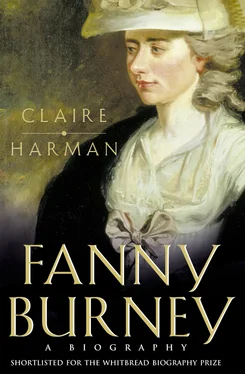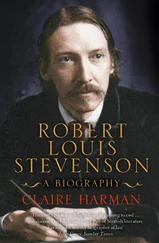The children had always been close, but they drew closer, Fanny and Susan especially. Two anecdotes about them in their father’s fragmentary memoirs illustrate both his pleasure in their childish charms and the girls’ characteristics of sense and sensibility respectively. The story about Susan, the tender-hearted darling of the family, dates from before Esther’s death. At the age of five, she was so overcome by the acting in a performance of the melodrama Jane Shore that she cried out from the box to the apparently starving heroine of the piece, ‘Ma’am, will you have my ollange?’ which, her father recalls, ‘the audience applauded much more than the artificial complaints of the actress’. 81 The story about Fanny illustrates her ‘natural simplicity and probity’, which in Charles Burney’s view had ‘wanted no teaching’. She and her sisters were playing with the wigmaker’s children next door:
[T]he door of the wig magazine being left open, they each of them put on one of those dignified ornaments of the head, and danced and jumped about in a thousand antics, laughing till they screamed at their own ridiculous figures. Unfortunately, in their vagaries, one of the flaxen wigs, said by the proprietor to be worth upwards of ten guineas – in those days a price enormous – fell into a tub of water, placed for the shrubs in the little garden, and lost all its gorgon buckle, and was declared by the owner to be totally spoilt. He was extremely angry, and chid very severely his own children; when my little daughter, the old lady, then ten years of age, advancing to him, as I was informed, with great gravity and composure, sedately says; ‘What signifies talking so much about an accident? The wig is wet, to be sure; and the wig was a good wig, to be sure; but its of no use to speak of it any more; because what’s done can’t be undone’. 82
This story is made to sound comical in the Memoirs , * and the thought of the little girls running round in judges’ and advocates’ wigs, screaming with laughter – until the accident, and probably then still sniggering – is a charming one. But it has a melancholy undertow. What’s done can’t be undone . If the statement of Fanny’s age is accurate, the incident took place in the year when Esther was dying or dead. The coining of such a fatalistic apothegm by a ten-year-old (‘the wig is wet’ became family shorthand for any situation that had got beyond their control) suggests an unusual degree of reflectiveness. It must have served to remind the wigmaker quite sharply that the ruination of a hair-piece was a relatively paltry loss.
Fanny was referred to in that story as ‘the old lady’, a nickname which settled on her ‘from the time she had reached her eleventh year’. In a passage from the Memoirs apparently ‘Copied from a Memorandum-book of Dr. Burney’s’, * she has her father recall:
in company, or before strangers, [Fanny] was silent, backward, timid, even to sheepishness: and, from her shyness, had such profound gravity and composure of features, that those of my friends who came often to my house, and entered into the different humours of the children, never called Fanny by any other name, from the time she had reached her eleventh year, than The Old Lady. 83
Fanny would not have left this in the record if she had not thought it to her credit. Behaving like an old lady, decorously, soberly and with ‘gravity and composure of features’, was for her the only proper way. ‘From the time she had reached her eleventh year’ clearly aligns the onset of ‘profound gravity’ with her mother’s death, after which it may have seemed to Fanny irreverent and inappropriate to be gay in public – in her novels, only the heartless characters ‘get over’ a death. People often described Fanny Burney as ‘shy’, but ‘reserved’ seems a much more accurate word. From her diaries and letters, which exist from her sixteenth year, we know that, privately, she was sharp, witty, devastatingly observant, judgemental, romantic and prone to ‘fits’ of irrepressible high spirits. Her sobersides public persona was clearly a form of camouflage, developed through the long habit of not wanting to have attention drawn to herself, with the criticism she imagined would inevitably follow of her looks, her melancholy, her ‘backwardness’, her lack of polish. To be reserved was also to be preserved.
*According to the ‘Worcester Memoirs’. Wycherley died in 1716, aged about seventy-six, and Ann Cooper was born in 1690, but although it sounds an unlikely courtship, Wycherley in fact married a woman even younger than Ann a fortnight before his death.
*Margaret Anne Doody’s suggestion that a homosexual attraction between Greville and Burney ‘does not seem impossible’ 14 seems to me too far-fetched to be helpful in this connection.
*Esther Sleepe’s parentage and date of birth are difficult to ascertain, and scholars disagree over them. She is either the ‘Esther ye Daugh’ of Mr Sleepe by – his Wife’ born 19 May 1723 and baptised on 9 June at St Vedast, Foster Lane (Joyce Hemlow’s choice), or the Hester, daughter of Richard and Frances Sleepe baptised at St Michael le Quern on 1 August 1725 (the choice of the editors of Dr Burney’s memoirs). Professor Hemlow bases her decision on the information given by Esther’s great-grandson, Richard Allen Burney, in his application to the College of Arms in 1807, where he names her father as ‘James Sleepe of Foster Lane’. The Memoir editors cite the passage by Dr Burney that describes his first wife thus: ‘the daughter of old Sleepe, the head of the City waits and furnisher of bands for municipal festivities, and Mrs Sleepe, the daughter of a M. Dubois, who kept a Fan Shop in Cheapside’. This encourages the identification of Esther’s father as Richard Sleepe, a freeman of the Company of Musicians (as was she) and leader of the City waits (the Lord Mayor’s band), who died in 1758. He married a Frances Wood in 1705, whom the Memoir editors reasonably assume was the daughter of the M. Dubois mentioned in Dr Burney’s account, with her surname anglicised, as were those of many exiled Huguenots. 18 The two ‘Mr Sleepe’s could, of course, have been one and the same person (there is no mention of the name ‘James’ except in the 1807 document), or they could have been brothers. It also strikes me as a strong possibility that the two registered births – of ‘Esther Sleepe’ (1723) and ‘Hester Sleepe’ (1725) respectively – were those of sisters, and that the second girl was given, as was very often the case, the name of a sibling who had died in infancy. The likelihood of ‘Mr Sleepe’ and ‘Richard Sleepe’ being the same man and Esther and Hester sisters is increased by the fact that after the Great Fire of 1666, the parish of St Michael le Quern was amalgamated with that of its neighbour, St Vedast, Foster Lane (both churches having been destroyed, and only St Vedast rebuilt – by Wren). The two girl babies were therefore baptised at the same font, two years apart, and not at two different churches, as scholars have hitherto assumed. This would favour the identification of Esther as the daughter of Richard Sleepe, d.1758, and Frances Wood (Dubois), d. before 1776, who was baptised on 1 August 1725, which I take to be correct. 19 Professor Hemlow’s alternative identification is further weakened by the uncertain reliability of Richard Allen Burney’s information. Known in the family as a snob (an accusation which seems borne out by his desire to acquire a coat of arms), Richard Allen Burney was trying to present his genealogy to the College of Arms in the best possible light. As I discuss elsewhere (see Preface), he may not have known of his own mother’s illegitimacy; or if he did, he concealed it from the College. His apparent knowledge of a ‘James Sleepe of Foster Lane’ may have been handed down in the family (though it is odd that it disagrees with Dr Burney’s version), or perhaps extrapolated, for purposes of establishing some presentable facts, from the very records which Professor Hemlow used to corroborate his evidence.
Читать дальше












